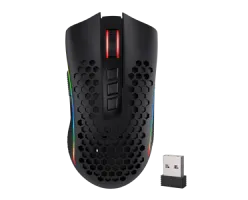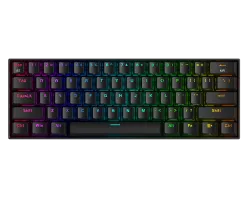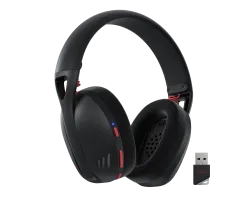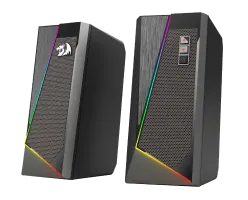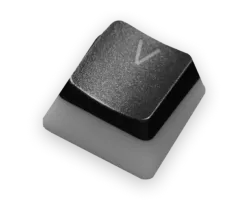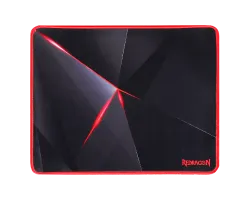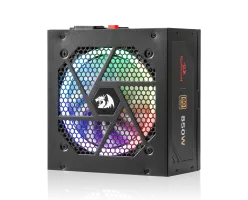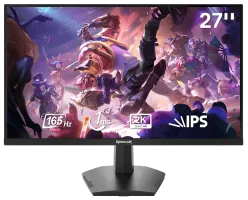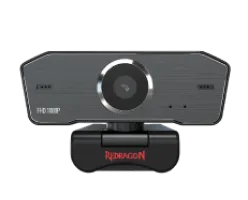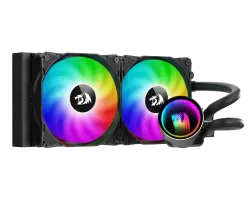Key points of M719 Mouse:
1) 10-million clicks Omron main switches, anticipate 5yr use for ~$15
2) Decent mid-range name brand PMW3325 sensor, much better than office mouse
3) RGB flashiness customizable / can be turned OFF
4) Onboard memory remembers settings between shutdowns, and different computers.
5) Almost all main features accessible with buttons, Software not required, but can be helpful
6) Software is only necessary if want to set specific color, or use specific macros.
7) Black braided cable less stiff than older Redragon mice, gold-plated USB-A plug
8) Features comparable to name brand mice ~$20+, good value at 1/2 to 2/3 price.
Some potential negatives:
1) 5 RGB Light modes, not 6 as stated in manual - missing "Without a Trace"
2) RGB lighting with "main" rainbow colors are vibrant, off shades appear washed out.
2) Sensor is not mid-line, it is off-center to the right. Does NOT affect accuracy in use
3) Comes in a hard plastic box. Cool, but amazon may not cushion it properly for shipping.
M719 comes with:
1) Omron switches rated for 10-million clicks - 2x my current mouse, so anticipate 5+ yrs use.
2) Pixart PMW3325 mid-range sensor - much better than office mouse / current mouse
3) Ergonomics that closely resembles the popular Logitech 203/G Pro series mice.
4) Flashy RGB LED goodness that can mesmerize, and then quickly be turned OFF. :)
5) All main features accessible via buttons. Settings remembered via onboard memory.
Shape and Outer Shell:
The mouse is small, low profile but not uncomfortably so. The Logitech ambidextrous shape is popular for a reason. I use a fingertip grip, and typically move the mouse with pinkie and thumb - which works well for me.
----
Key Points of Comparison between M719,
M711, and the
M711-FPS:
01) M719 and M711: share same mid-range button switches and mid-range sensor.
02) M719 and M711: RGB can be turned of entirely.
03) M719 and M711: Software is optional, most of features can be operated with buttons.
04) M719 and M711: Onboard memory for all settings, remembers between restarts, diff computers.
05) M719 moves a button to the left front as the "Rapid Fire / Sniper" Button.
06) M711 has center-line sensor placement, while M719 is offset 1 cm to right.
07) RGB is better on the M711 design, 2 more modes, and little more vibrant
08) M711-FPS is same shell and RGB as the M711, but has top of the line sensor
09) M711-FPS also feature optical button switches that are rated 50-million clicks
10) M719/M711 hoped to be good for ~5yrs based on 10-million clicks button durability
11) The M711-FPS can be reasonably expected to last 10+ years of casual use
So I would probably expect 5+ years of trouble free use out of the M719/M711.
Double that price for 10+ years, plus a better sensor in the M711-FPS.
Hope that's helpful in making a decision for the right mouse for you.
====
Continue for more details and explanations.
Background for my Purchase:
M719 Mouse was purchased to replace a Redragon M601 that's been in daily use for 3 years. Used for Productivity / Casual Gaming. The main button switches were rated 5-million clicks, that rating in my case will last about 2.5 years of trouble-free use. Recently it began misclicking,
misdragging/dropping items on the desktop. So it was time for a replacement.
I like to value shop, so I set targets and then try to find the best prices.Feature Goals of a replacement mouse, in order of importance:
1) Durability. Good button lifespan rating for the price of the mouse. I paid ~$12.50 for a 5-million clicks mouse, and it lasted about 2.5 yrs. So I expect at least 5 yrs use from 10-million clicks buttons of a new $15 mouse. New upper range mice are 20-million clicks, and the super high-end mice boast 50-million click omron switches for the main buttons.
2) Optical Sensor. In general the current best mouse sensor is the PMW3360, or variants of it. That is only if you require the mouse to track while whipping it across a decent sized mouse pad and place very accurate clicks despite high accelerations and sudden movements. I don't play competitive games, so I just need a mid range sensor that is accurate and can be moved moderately quickly. Obviously, if I can find a PMW3360 for a good price it would be even better.
I prioritize button durability over sensor features because in my experience, buttons wear out before sensors stop working. I know there are ways to DIY replace the button switches, but most people would not do that for a budget mouse.
3) Ergonomics. I want a commonly recognized shape that is comfortable. Obvious.
4) Aesthetics. I prefer function over form when looking for a value mouse. So RGB is flashy, nice to have, but not a top concern. I also don't want a crazy looking mouse with overly aggressive design.
----
So with that, I found the feature set of the M719 very appealing on Cyber Monday. For under $15, it comes with:
1) Omron switches rated for 10-million clicks - 2x my current mouse, so anticipate 5+ yrs use.
2) Pixart PMW3325 mid-range sensor - much better than office mouse / current mouse
3) Ergonomics that closely resembles the popular Logitech 203/G Pro series mice.
4) Flashy RGB LED goodness that can mesmerize, and then quickly be turned OFF. :)
5) All main features accessible via buttons. Settings remembered via onboard memory.
Shape and Outer Shell:
The mouse is small, low profile but not uncomfortably so. The Logitech ambidextrous shape
is popular for a reason. I use a fingertip grip, and typically move the mouse with pinkie
and thumb - which works well for me.
The hard plastic shell seem more refined than the M601. The top is a velvety matte finish,
almost as if sand blasted, while the sides are hard plastic with polygonal textures. Good thing about the matte finish is that it feels nice, and is not the spray-on "soft rubber" that is often used in cheap electronics and melts to a sticky gooey mess after a few years. A potential down-side is that matte plastic scratches easily, and with wear, I would anticipate "bald" shiny spots over time.
Buttons:
Compared to the M601, I found the main buttons responsive. The LMB and RMB are easy
to click, but because I tend to place my finger tips closer to the hinge area, they are stiffer for me than the M601 (which has a hinge further towards the back of the mouse). If your finger tips reach more towards the front, then they click just as easily. I've adjusted to this difference after a few hours use.
Side buttons are better and have less loose dead travel than on the M601. The two mode buttons for DPI and RGB are both smooth, and can be difficult to distinguish without looking. The DPI cycles as you'd expect; the RGB cycle includes 5 light modes and a OFF mode. - no light strip/logo
There is an additional button on the left side, forward of the two side button. Actually difficult to reach, but perhaps easier for someone with larger hands. By default, one click of it sends LMB x3 to the computer at 10ms intervals.
Bonus features of the M719.
Software NOT required:
Great majority of the features can be operated from the buttons on the mouse, there is NO absolute need to install software to get the mouse working. Preset DPI settings are quite adequate for single 1080p and 1440p screen sizes. The software is generally intuitive, and has more features than most would need. With the software, all the buttons can be reset to any of the available functions for buttons. The scroll wheel can also be assigned some appropriate functions if desired.
RGB lighting modes can be cycled with the RGB button, or button set to 'RGB Mode Cycle'.
Breathing (BREATHE) - light on, then gradual fade out.
Rainbow (RAINBOW) - shifting solid color, one color at a time, and cycles.
Full lighted (SOLID) - basically single steady color.
Wave (WAVE) - is a multi-color spectrum across the mouse all at once, moves like ripple
Flashing (FLASH) - is like like your car hazard blinkers
** However, must note that there are only FIVE (5) RGB modes, and not the SIX (6) described in the manual. ( BREATHE / RAINBOW / SOLID / WAVE / FLASH ) and a (LED OFF) mode. Manual says there is a "Go Without Trace" mode, but cycling via the button, and also using the software confirms that this mode does not exist. I had intended to add more comments on the software. But you can download the specific software and look at the way it is set up, even without the mouse. So I'll just say it was better than expected. Lighting setting are reflected between software and mouse immediately (set by button on mouse, or via onscreen tabs). DPI settings are not updated as intuitively, but easy to work out.
If the software does not seem to work, make sure you reboot/restart after initial installation - especially if you have other mouse software active. I will probably uninstall the software after a while, not because it is bad, but because I doubt I will need all the features it provides. I like a
smaller less complicated system.
Details on Omron switch superiority can be easily found via Internet search. Pixart PMW3325 features and evaluation can also be found likewise.
Hope above provides enough data to make informed purchase decisions. I found the above features to be a good value for the price it was offered.
Author: Robhi




